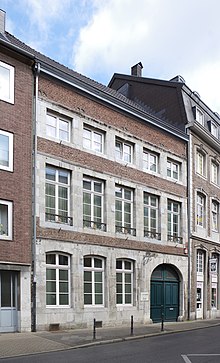Marianneninstitut
The Marianneninstitut was a maternity ward for poor women who had recently given birth in Aachen and the first of its kind in Prussia . The institute was founded in 1830 by the Aachen gynecologist and obstetrician Vitus Jakob Metz (1792–1866) and recorded more than 40,000 births before it closed in 1959. It was named after Princess Marianne of Prussia , the wife of Prince Wilhelm of Prussia .
history
After a Société de maternité had already existed during the French administration of Aachen , which looked after impoverished women who had recently given birth, especially from working-class neighborhoods, there was initially no comparable institution after the French withdrew. This prompted the Aachen gynecologist and obstetrician Vitus Jakob Metz on May 1, 1830, to appeal to Aachen's politicians and financially strong entrepreneurs, and in particular to their wives, to help set up a maternity care institution through financial allocations and donations in kind. The maternity home should only be intended for poor and abandoned mothers, and it should also be supplemented with a school for "nurses" (nurses).
Just a few days after the appeal, a women's association was founded for this purpose, which immediately elected its first board. This included the wives of the District President August von Reiman and the Vice President of the Government von Mallinckroth, the entrepreneur's wife Barbara Startz and the medical wife Therese von Sartorius as well as the only male members of the founding initiator Vitus Jakob Metz and the pharmacist Johann Peter Joseph Monheim . The paleontologist Joseph Müller was hired as secretary . After sufficient funds and donations in kind had been acquired in the following months and suitable premises had been found and the sponsorship of the Princess of Prussia had been promised, the Marianneninstitut was opened on August 3, 1830 in Aachen's Bendelsstrasse No. 20, initially with six to eight beds Vitus Metz to be appointed first director. It was the first maternity hospital in Germany, and it was not until 1882 that a second maternity home followed in Düsseldorf .
In the Marianneninstitut "recognized needy, virtuous, married women regardless of religion" were accepted for nine days. During this time, she and her respective child were provided with everything that was needed free of charge, from “institutional clothing”, nutrition and regular medical examinations to training in dealing with babies. Word got around quickly about this new institution in Aachen and the supporting women's association was able to significantly increase its membership as well as collect more donations. The fee for the midwives as well as the costs of the necessary medicines and instruments or possible burials were disputed by the “Poor Administration Commission”. In the first year 82 children were born here and by 1838 the number rose to 976 births. Quite soon, additional rooms for 57 beds had to be made available and their equipment added. In addition to numerous private individuals, many clubs, associations and institutions, including the casino, the Aachener Feuer-Versicherungs-Gesellschaft and the Aachener Liedertafel, responded to the necessary constant calls for donations by the women's association .
After the premises in Bendelstrasse were no longer sufficient for the birth, the Marianneninstitut moved to the house at Jakobstrasse 18 in 1897. In this house, which from time immemorial bore the name "Zum güldenen Verken" ("To the golden pig"), initially housed the guild house of the Nadler and was part of the needle factory Chorus , which extended to the Haus zum Horn , and from 1879 to In 1881 a brewery building and then a seltzer water factory until the Marianneninstitut moved in . In 1901, an extra wing was built for the maternity hospital in the rear area of the Annuntiatenbach with money from the foundation fund of Philipp Heinrich Cockerill , which was named “Refuge” and in which unmarried women who had recently given birth could stay. The fathers of these illegitimate children were not allowed into the building and could only see their children from the outside through the windows.
After the Marienhospital Aachen received a gynecological and obstetric department in 1957 and a spacious new building for a children's clinic was built at the city hospitals in Aachen's Goethestrasse, the Marianneninstitut became superfluous and had to be closed in 1959. Only a plaque at House 18 in Jakobstrasse reminds of the former maternity ward that was housed there.
In addition to Vitus Metz, his successor, the district physicist Gerhard Schervier (1821-1891), with more than 5,000 births in 26 years of service, and his successor, the Secret Sanitary Councilor Eugène Beaucamp (1859-1936) who gave birth to 17,026 children in almost 32 years. In the last few years before it was closed, the future general practitioner and psychotherapist Waltraut Kruse had worked as a medical assistant in the birthing center .
Ambassador Walter von den Driesch , cathedral builder Helmut Maintz , local historian Bruno Lerho and politician Karl Schultheis saw the light of day at the Marianneninstitut .
literature
- Vitus Jakob Metz: The Marianneninstitut zu Aachen , Mayer, Aachen 1838 digitized
- Eugène Beaucamp: Festschrift for August 3, 1930 commemorating the centenary of the Mariannen Institute - asylum for women in maternity leave - in Aachen . La Ruelle, Aachen 1930
- Egon Schmitz-Cliever : The establishment of the first asylum for women in maternity leave in Germany (1830) , in: Sudhoffs Archiv, Volume 50, H. 2, Franz Steiner-Verlag, 1966, pp. 136–156 Abstract
- Bruno Lerho: Back then in Aachen, Burtscheid & Forst ; Helios Verlag, 2016
Web links
- Hannelore Follmer: The Marianneninstitut and the pigs , history and Ameröllchen on Unser-aachen.de from April 24, 2016
